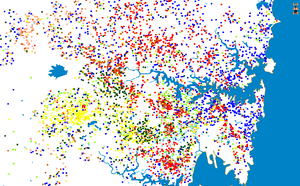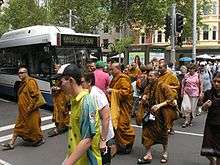Demographics of Sydney
Sydney is Australia's most populous city, and is also the most populous city in Oceania. In the 2016 census, 5,005,400 persons declared themselves as residents of the Sydney Statistical Division–about one-fifth (19.41%) of Australia's total population. With a population density of 2037 people per square kilometer the urban core has population density five times that of the greater region.[1][2]

Sydney is the most densely populated city in Australia and is also the busiest city in Australia. The median age of Sydney residents was 35 years, and households comprised an average of 2.7 members.[3][4]
History
| Sydney population by year | ||
|---|---|---|
| 1796 | 2,953 | [5] |
| 1828 | 10,815 | [6] |
| 1833 | 16,232 | |
| 1836 | 19,729 | |
| 1841 | 29,973 | |
| 1846 | 38,358 | |
| 1851 | 44,240 | |
| 1856 | 53,358 | |
| 1911 | 629,503 | [7] |
| 1954 | 1,863,217 | |
| 1961 | 2,183,231 | |
| 1971 | 2,807,828 | |
| 1981 | 3,204,696 | |
| 1991 | 3,672,855 | |
| 1996 | 3,881,136 | |
| 2001 | 4,128,272 | |
| 2006 | 4,281,988 | |
| 2011 | 4,627,345 | |
| 2016 | 5,005,400 | |
European settlement in Sydney began in 1788, and in 1800 Sydney had around 3,000 non-indigenous inhabitants. It took time for the city's population to grow–in 1851 its population was only 39,000, compared with 77,000 in Melbourne. The subsequent gold rushes in Victoria caused the population of Melbourne to increase rapidly, while the lesser gold rushes in New South Wales had a less profound effect on the population of Sydney.
Sydney overtook Melbourne as Australia's most populous city in the early twentieth century, and reached the million inhabitants milestone around 1925. The opening of the Sydney Harbour Bridge helped pave the way for further urban development north of Sydney Harbour. Post-war immigration and a baby boom helped the population reach two million by 1962. Sydney remained Australia's most populous city throughout the 20th century, and is projected to retain this position for much of the 21st century.[8]
At the June 2016 Australian census, Sydney's population reached 5 million people.[1]
Density
Sydney is particularly noted for its low population density, due to its history. Surrounded by land that was considered unowned by the city's founders, early Sydney enjoyed relatively low land values. Coupled with successive governments' willingness to release new land on the city's outskirts for further development, this history has given Sydney a low-density self-image.[9][10]
Multiculturalism
| Country of Birth (2016)[11][12] | |
| Birthplace[N 1] | Population |
|---|---|
| Australia | 2,752,119 |
| Mainland China | 224,685 |
| England | 151,614 |
| India | 130,573 |
| New Zealand | 86,526 |
| Vietnam | 81,045 |
| Philippines | 75,480 |
| Lebanon | 55,979 |
| South Korea | 49,508 |
| Hong Kong | 40,577 |
| Italy | 40,492 |
| Iraq | 39,237 |
| South Africa | 35,313 |
| Fiji | 31,510 |
| Nepal | 30,424 |
| Indonesia | 29,989 |
| Malaysia | 21,211 |
Most immigrants to Sydney between 1840 and 1930 were British, Irish or Chinese. At the 2016 census, the most commonly nominated ancestries were:[N 2][13]
At the 2016 census, there were 2,071,872 people living in Sydney that were born overseas, accounting for 42.9% of the population Sydney,[15] above Vancouver (42.5%), Los Angeles (37.7%), New York City (37.5%), Chicago (20.7%%), Paris (14.6%) and Berlin (13%). Only 33.1% of the population had both parents born in Australia.[16] Sydney has the eighth-largest immigrant population among world metropolitan areas. Foreign countries of birth with the greatest representation are Mainland China, England, India, New Zealand, Vietnam and the Philippines.[17]
38.2% of people in Sydney speak a language other than English at home with Mandarin (4.7%), Arabic (4.0%), Cantonese (2.9%), Vietnamese (2.1%) and Greek (1.6%) the most widely spoken.[18]
1.5% of the population, or 70,135 people, identified as Indigenous Australians (Aboriginal Australians and Torres Strait Islanders) in 2016.[N 5][19][20]
Sydney has been a hub of a number of migrant communities, such as the Lebanese, Fijian, Korean and Nepalese.[21] Well over half of Australia's 25,000-strong Nepalese community,[22] for example, is concentrated in Sydney.[23] Seven out of every ten Lebanese migrants in Australia live in Sydney.[21] The Ghanaian community has been noted as being quite visible in Sydney, with the number of Ghanaian churches being unusually large considering the relatively small number of Ghanaians in Australia.[24] Furthermore, the suburb of Fairfield in the Greater Western Sydney area, is an ethnic enclave of Assyrian Christians,[25] where they are the largest ethnic group in the suburb and also in the surrounding areas of Fairfield Heights, Prairiewood and Greenfield Park.[26] There is a Romani community in Sydney.[27]

The most common languages spoken at home are English (the sole language of 60.8% of the population), Arabic (spoken by 4.4%), Cantonese (3.4%), Mandarin (2.6%), Greek (2.2%) and Vietnamese (2.0%).[28]
Religion

At the 2006 Census, the most common responses for religion were Catholic (29.2%), Anglican (16.5%), Eastern Orthodox (4.8%) and Islam (4.4%). 14.1% declared no religious affiliation.[28] 10.4% left the question blank, 3.7% were Buddhists, 1.7% were Hindu, 0.9% were Jewish.
The 2011 Census most common responses were Catholic, (28.3%), Anglican (14.7%), Islam (5.3%) and Eastern Orthodox (4.6%). 17.5% declared no religion.[29]
In 2016, the most common responses for religion in Greater Sydney were Catholic 25.1%, No Religion, so described 24.6%, Anglican 12.0%, Not stated 8.8% and Islam 5.3%.[30]
See also
| Wikimedia Commons has media related to Demographic maps of Sydney. |
- Demographics of Australia
- Immigration to Australia
- List of population demographics of New South Wales by local government area
Notes
- In accordance with the Australian Bureau of Statistics source, England, Scotland, Mainland China and the Special Administrative Regions of Hong Kong and Macau are listed separately
- As a percentage of 4,519,022 persons who nominated their ancestry at the 2016 census.
- The Australian Bureau of Statistics has stated that most who nominate "Australian" as their ancestry are part of the Anglo-Celtic group.[14]
- Of any ancestry. Includes those identifying as Aboriginal Australians or Torres Strait Islanders. Indigenous identification is separate to the ancestry question on the Australian Census and persons identifying as Aboriginal or Torres Strait Islander may identify any ancestry.
- Of any ancestry. Includes those identifying as Aboriginal Australians or Torres Strait Islanders. Indigenous identification is separate to the ancestry question on the Australian Census and persons identifying as Aboriginal or Torres Strait Islander may identify any ancestry.
References
- "Sydney population hits 5 million". Australian Bureau of Statistics. 30 March 2017. Archived from the original on 28 July 2017. Retrieved 5 April 2017.
- "3218.0 – Regional Population Growth, Australia, 2014–15: Media Release Sydney on target to Take Five". Australian Bureau of Statistics. 30 March 2016. Archived from the original on 28 July 2017. Retrieved 27 October 2016.
- "National Regional Profile: Sydney (Statistical Division)". ABS.gov.au. Retrieved 13 June 2015.
- "2032.0 - Census of Population and Housing: Australia in Profile -- A Regional Analysis, 2001", Australian Bureau of Statistics, 2004-01-16
- "3105.0.65.001 - Australian Historical Population Statistics, 2006". Australian Bureau of Statistics. 23 May 2006. Retrieved 21 November 2011.Table 1. Population by sex, states and territories, 31 December 1788 onwards
- "CENSUS". New South Wales Government Gazette. New South Wales, Australia. 28 March 1857. p. x. Retrieved 28 April 2020 – via Trove.
- "Australian Historical Population Statistics, 2008". Australian Bureau of Statistics. 5 August 2008. Retrieved 21 November 2011.
- "3222.0 – Population Projections, Australia, 2006 to 2101". Australian Bureau of Statistics. 4 September 2008. Retrieved 21 November 2011.
- Forster 1995.
- 1217.0.55.001 - Glossary of Statistical Geography Terminology, 2003, Australian Bureau of Statistics, 2003
- https://quickstats.censusdata.abs.gov.au/census_services/getproduct/census/2016/communityprofile/1GSYD?opendocument
- http://www.censusdata.abs.gov.au/CensusOutput/copsub2016.NSF/All%20docs%20by%20catNo/2016~Community%20Profile~1GSYD/$File/GCP_1GSYD.zip?OpenElement
- https://quickstats.censusdata.abs.gov.au/census_services/getproduct/census/2016/communityprofile/1GSYD?opendocument
- Statistics, c=AU; o=Commonwealth of Australia; ou=Australian Bureau of. "Feature Article - Ethnic and Cultural Diversity in Australia (Feature Article)". www.abs.gov.au.
- https://quickstats.censusdata.abs.gov.au/census_services/getproduct/census/2016/quickstat/1GSYD?opendocument
- https://quickstats.censusdata.abs.gov.au/census_services/getproduct/census/2016/quickstat/1GSYD?opendocument
- https://quickstats.censusdata.abs.gov.au/census_services/getproduct/census/2016/quickstat/1GSYD?opendocument
- https://quickstats.censusdata.abs.gov.au/census_services/getproduct/census/2016/quickstat/1GSYD?opendocument
- https://quickstats.censusdata.abs.gov.au/census_services/getproduct/census/2016/communityprofile/1GSYD?opendocument
- http://www.censusdata.abs.gov.au/CensusOutput/copsub2016.NSF/All%20docs%20by%20catNo/2016~Community%20Profile~1GSYD/$File/GCP_1GSYD.zip?OpenElement
- "2016 Census Community Profiles - Greater Sydney". Australian Bureau of Statistics. Retrieved 18 March 2018.
- "People in Australia who were born in Nepal". Australian Bureau of Statistics.
- "People in Greater Sydney who were born in Nepal". Australian Bureau of Statistics.
- "Patriotic to a fault". Australian Broadcasting Corporation.
- Australian Bureau of Statistics (27 June 2017). "Fairfield (State Suburb)". 2016 Census QuickStats. Retrieved 27 June 2017.

- B. Furze, P. Savy, R. Brym, J. Lie, Sociology in Today's World, 2008, p. 349
- Australian Bureau of Statistics (25 October 2007). "Sydney (Urban Centre/Locality)". 2006 Census QuickStats. Retrieved 23 November 2011. Map
- http://www.censusdata.abs.gov.au/census_services/getproduct/census/2011/quickstat/UCL101001?opendocument&navpos=220
- "2016 Census QuickStats Greater Sydney". Australian Bureau of Statistics. Australian Government. 2017. Retrieved 5 July 2017.,